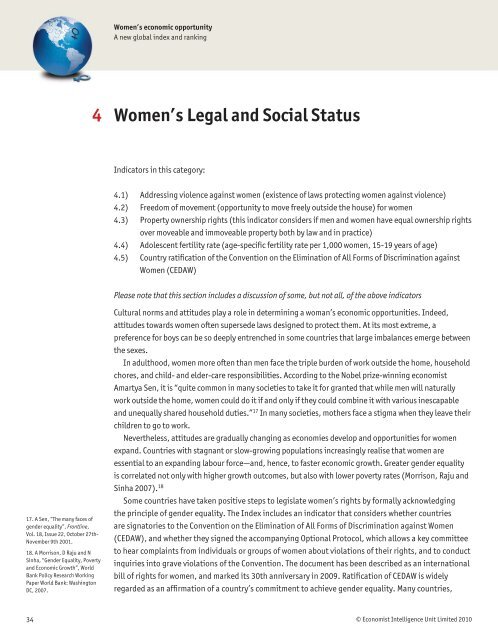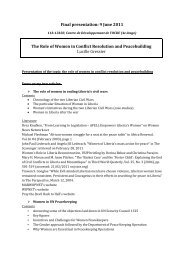Women's Economic Opportunity Index - Economist Intelligence Unit
Women's Economic Opportunity Index - Economist Intelligence Unit
Women's Economic Opportunity Index - Economist Intelligence Unit
- No tags were found...
Create successful ePaper yourself
Turn your PDF publications into a flip-book with our unique Google optimized e-Paper software.
Women’s economic opportunityA new global index and ranking4Women’s Legal and Social StatusIndicators in this category:4.1) Addressing violence against women (existence of laws protecting women against violence)4.2) Freedom of movement (opportunity to move freely outside the house) for women4.3) Property ownership rights (this indicator considers if men and women have equal ownership rightsover moveable and immoveable property both by law and in practice)4.4) Adolescent fertility rate (age-specific fertility rate per 1,000 women, 15-19 years of age)4.5) Country ratification of the Convention on the Elimination of All Forms of Discrimination againstWomen (CEDAW)Please note that this section includes a discussion of some, but not all, of the above indicators17. A Sen, “The many faces ofgender equality”, Frontline,Vol. 18, Issue 22, October 27th-November 9th 2001.18. A Morrison, D Raju and NSinha, “Gender Equality, Povertyand <strong>Economic</strong> Growth”, WorldBank Policy Research WorkingPaper World Bank: WashingtonDC, 2007.Cultural norms and attitudes play a role in determining a woman’s economic opportunities. Indeed,attitudes towards women often supersede laws designed to protect them. At its most extreme, apreference for boys can be so deeply entrenched in some countries that large imbalances emerge betweenthe sexes.In adulthood, women more often than men face the triple burden of work outside the home, householdchores, and child- and elder-care responsibilities. According to the Nobel prize-winning economistAmartya Sen, it is “quite common in many societies to take it for granted that while men will naturallywork outside the home, women could do it if and only if they could combine it with various inescapableand unequally shared household duties.” 17 In many societies, mothers face a stigma when they leave theirchildren to go to work.Nevertheless, attitudes are gradually changing as economies develop and opportunities for womenexpand. Countries with stagnant or slow-growing populations increasingly realise that women areessential to an expanding labour force—and, hence, to faster economic growth. Greater gender equalityis correlated not only with higher growth outcomes, but also with lower poverty rates (Morrison, Raju andSinha 2007). 18Some countries have taken positive steps to legislate women’s rights by formally acknowledgingthe principle of gender equality. The <strong>Index</strong> includes an indicator that considers whether countriesare signatories to the Convention on the Elimination of All Forms of Discrimination against Women(CEDAW), and whether they signed the accompanying Optional Protocol, which allows a key committeeto hear complaints from individuals or groups of women about violations of their rights, and to conductinquiries into grave violations of the Convention. The document has been described as an internationalbill of rights for women, and marked its 30th anniversary in 2009. Ratification of CEDAW is widelyregarded as an affirmation of a country’s commitment to achieve gender equality. Many countries,34© <strong>Economist</strong> <strong>Intelligence</strong> <strong>Unit</strong> Limited 2010




